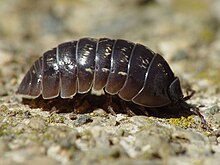Armadillidium vulgare
| Armadillidium vulgare | |
|---|---|

| |
| Scientific classification | |
| Domain: | Eukaryota |
| Kingdom: | Animalia |
| Phylum: | Arthropoda |
| Class: | Malacostraca |
| Superorder: | Peracarida |
| Order: | Isopoda |
| Suborder: | Oniscidea |
| Family: | Armadillidiidae |
| Genus: | Armadillidium |
| Species: | A. vulgare
|
| Binomial name | |
| Armadillidium vulgare | |
| Synonyms [2] | |
| |
Armadillidium vulgare, the common pill-bug, potato bug, common pill woodlouse, roly-poly, slater, doodle bug, or carpenter, is a widespread European species of woodlouse. It is the most extensively investigated terrestrial isopod species.[2] It is native to Mediterranean Europe but has accompanied humans throughout their travels and now are found, naturalized in almost all suitable ecosystems. They are kept as pets by hobbyists for their wide range of possible color variations.
Description
Armadillidium vulgare may reach a length of 18 millimetres (11⁄16 in), and is capable of rolling into a ball when disturbed; this ability, along with its general appearance, gives it the name pill-bug and also creates the potential for confusion with pill millipedes such as Glomeris marginata.[3] It can be distinguished from Armadillidium nasatum and Armadillidium depressum by the gap that A. nasatum and A. depressum leave when rolling into a ball; A. vulgare does not leave such a gap.[4]
Ecology
Armadillidium vulgare is able to withstand drier conditions than many other woodlouse species, and is restricted to calcareous soils or coastal areas.[3] It feeds chiefly on decaying plant matter, but also grazes lichens and algae from tree bark and walls.[5]
It is able to regulate its temperature through its behaviour, preferring bright sunshine when temperatures are low, but remaining in shadow when temperatures are high; temperatures below −2 °C (28 °F) or above 36 °C (97 °F) are lethal to it.[6] A. vulgare is less susceptible to cold during the night, and may enter a state of dormancy during the winter in order to survive temperatures that would otherwise be lethal.[6]
Distribution
The native distribution of A. vulgare ranges across Europe, especially in the Mediterranean Basin.[2] In the United Kingdom, A. vulgare is very common in southern and eastern England, but is more confined to coastal areas in the north.[7] Similarly, in Ireland, A. vulgare is common in the south and east, but rarer in the north and west.[7]
A. vulgare has also been introduced to many locations in North America, where it may reach population densities of up to 10,000 individuals per square metre (900 individuals per square foot).[8] It is now one of the most abundant invertebrate species in California coastal grassland habitats.[9] It has also been introduced, to a lesser extent, to sites across the world.[2]
Relationships with humans
Because of their unusual yet non-threatening appearance, some Armadillidium vulgare are kept as pets in areas throughout the world. Different lineages are bred, usually in regards to color, in order to provide stock to hobbyists. One supposed variation, "Punta Cana," is often referred to as Armadillidium sordidum, while others insist it is a variety of A. vulgare.[10] Keeping a pet pill bug requires a very moist habitat with limited light and abundant decaying botanical matter.[11] They can often live up to three years.[12] Among non-hobbyist adults, they are often seen as unwanted (but essentially harmless) home pests.[12]
Mitochondrial genome
Most metazoans have circular mitochondrial genomes, but A.vulgare has an unusual combination of both circular and linear mitochondrial DNA.[13]
Gallery
-
Armadillidium vulgare beginning to unroll from its defensive posture
-
Solid grey A. vulgare as adults
References
- ^ "Armadillidium vulgare". Integrated Taxonomic Information System.
- ^ a b c d Helmut Schmalfuss (2003). "World catalog of terrestrial isopods (Isopoda: Oniscidea) — revised and updated version" (PDF). Stuttgarter Beiträge zur Naturkunde, Serie A. 654: 341 pp. Archived from the original (PDF) on 2009-02-24. Retrieved 2009-02-13.
- ^ a b "Pill woodlouse (Armadillidium vulgare)". ARKive.org. Archived from the original on 2009-09-03. Retrieved February 13, 2009.
- ^ "Woodlouse Wizard: an identification key". Natural History Museum. Retrieved August 20, 2014.
- ^ "Common pill woodlouse — Armadillidium vulgare". Natural England. Archived from the original on July 20, 2011. Retrieved August 30, 2014.
- ^ a b Roberto Refinetti (1984). "Behavioral temperature regulation in the pill bug, Armadillidium vulgare (Isopoda)". Crustaceana. 47 (1): 29–43. doi:10.1163/156854084X00298.
- ^ a b "Armadillidium vulgare". Natural History Museum. Archived from the original on October 16, 2012. Retrieved November 7, 2010.
- ^ Jan Frouza; Richard Lobinske; Jirí Kalcík; Arshad Ali (2008). "Effects of the exotic crustacean, Armadillidium vulgare (Isopoda), and other macrofauna on organic matter dynamics in soil microcosms in a hardwood forest in central Florida". The Florida Entomologist. 91 (2): 328–331. doi:10.1653/0015-4040(2008)91[328:EOTECA]2.0.CO;2.
- ^ Oscar H. Paris (1963). "The ecology of Armadillidium vulgare (Isopoda: Oniscoidea) in California grassland: food, enemies, and weather". Ecological Monographs. 33 (1). Ecological Society of America: 1–22. doi:10.2307/1948475. JSTOR 1948475.
- ^ "Armadillidium vulgare var. "Punta Cana"". Archived from the original on May 29, 2019. Retrieved May 29, 2019.
- ^ Stanley A. Schultz & Marguerite J. Schultz (2009). The Tarantula Keeper's Guide: Comprehensive Information on Care, Housing, and Feeding. Barron's Educational Series. pp. 181–183. ISBN 978-0-7641-3885-0.
- ^ a b Smith-Rogers, Sheryl (October 2009). "Wild Thing: Roly-Poly Pillbugs". TPW Magazine. Retrieved July 10, 2010.
- ^ Marcadé, Isabelle; Cordaux, Richard; Doublet, Vincent; Debenest, Catherine; Bouchon, Didier; Raimond, Roland (2007). "Structure and Evolution of the Atypical Mitochondrial Genome of Armadillidium vulgare (Isopoda, Crustacea)". Journal of Molecular Evolution. 65 (6): 651–9. Bibcode:2007JMolE..65..651M. CiteSeerX 10.1.1.688.9796. doi:10.1007/s00239-007-9037-5. PMID 17906827. S2CID 25325865.
External links
 Media related to Armadillidium vulgare at Wikimedia Commons
Media related to Armadillidium vulgare at Wikimedia Commons Data related to Armadillidium vulgare at Wikispecies
Data related to Armadillidium vulgare at Wikispecies


